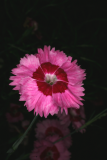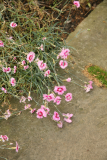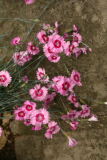Additional notes (click to expand)
Medicinal
Culpeper: says of the flowers: ‘Clove-gilliflowers, resist the pestilence, strengthen the heart, liver and stomach, and provokes lust.’
Culpeper, Nicholas. (1650). A Physical Directory . London, Peter Cole.
Culpeper (1649): “... Clove-gilliflowers resist the pestilence, strengthen the heart, liver and stomach, and provokes lust.” He also called it Betonica coronaria.
Notes: Pestilence was the bubonic plague, that was prevalent in London (and Europe generally) at that time. A bunch of carnations may still, at least, encourage affection (if not lust), but most hospitals now dislike flowers in their wards, whether affected by plague or not.
Oakeley, Dr. H. F. . (2013). The Gardens of the Pharmacopoeia Londinensis.
link
Nomenclature
Clove gilliflowers
Culpeper, Nicholas. (1650). A Physical Directory . London, Peter Cole.
Other use
They smell strongly of cloves, and an oil made from the petals is used in perfumery, soaps etc. The petals are sometimes used as a garnish for salads. In herbal medicine they are used to make a tonic.
Oakeley, Dr. H. F. . (2013). The Gardens of the Pharmacopoeia Londinensis.
link
Dianthus caryophyllus L. Caryophyllaceae Carnation, clove-gilliflowers - Mediterranean Culpeper (1650) writes that ‘Clove-gilliflowers, resist the pestilence, strengthen the heart, liver and stomach, and provokes lust.’ They smell strongly of cloves, and an oil made from the petals is used in perfumery, soaps etc. The petals are sometimes used as a garnish for salads. In herbal medicine they are used to make a tonic.
Oakeley, Dr. Henry F. (2013). Wellcome Library notes.
link
Geographical distribution
- Europe, Southwestern Europe, France
Dianthus caryophyllus L.
Family: CARYOPHYLLACEAEGenus: Dianthus
Species: caryophyllus L.
Common names: Carnation; Clove pink, Border carnation
Pharmacopoeia Londinensis name: Caryophylli
Distribution summary: probable origin mediterranean
Habit: Perennial
Hardiness: H3 - Half hardy; unheated greenhouse/mild winter
Habitat: Dry limestone soils
Garden status: Currently grown
Garden location: Europe & Mediterranean (E)
Flowering months: July, August
Reason for growing: Medicinal


.JPG)
.JPG)




.JPG)